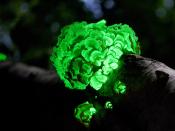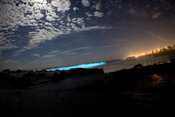- -
INTRODUCTION
What is Bioluminescence?
The current paper main focus is on bioluminescent Fungi but the basic features of bioluminescence discussed are common to all bioluminescent organisms. Bioluminescence is simply light created by living organisms. Probably the most commonly known example of bioluminescence by North Americans is the firefly, which lights its abdomen during its mating season to communicate with potential mates. This bioluminescent ability occurs in 25 different phyla many of which are totally unrelated and diverse with the phylum Fungi included in this list (an illustration of a bioluminescent fungi is displayed in figure 1). One of the features of biological light that distinguishes it from other forms of light is that it is cold light. Unlike the light of a candle, a lightbulb, bioluminescent light is produced with very little heat radiation. This aspect of bioluminescence especially interested early scientists who explored it. The light is the result of a biochemical reaction in which the oxidation of a compound called 'Luciferin' and the reaction was catalyzed by an enzyme called 'Luciferase'.
The light generated by this biochemical reaction has been utilized by scientists as a bioindicator for Tuberculosis as well as heavy metals. On going research involving bioluminescence is currently underway in the areas of evolution, ecology, histology, physiology, biochemistry, and biomedical applications.
History of Bioluminescent Fungi
The light of luminous wood was first noted in the early writings of Aristotle which occurred in 382 B.C.(Johnson and Yata 1966 and Newton 1952) The next mention of luminous wood in the literature occurred in 1667 by Robert Boyle who noticed glowing earth and noted that heat was absent from the light. Many early scientists such as Conrad Gesner, Francis Bacon, and Thomas Bartolin all observed and made notation of luminous earth(Johnson and Yata 1966 and Newton 1952...


